Who A Female Gender Is Change To Male
Introduction
Transsexualism (ICD-ten) or Gender Dysphoria (GD) (DSM-v) is characterized by intense and persistent cross-gender identification which influences several aspects of beliefs (i). The terms depict a situation where an individual's gender identity differs from external sexual beefcake at birth (ane). Gender identity-affirming care, for those who want, tin include hormone therapy and affirming surgeries, equally well equally other procedures such as hair removal or speech therapy (1).
Since 1998, the Gender Identity Plan (PROTIG) of the Infirmary de Clínicas de Porto Alegre (HCPA), Universidade Federal do Rio Grande do Sul, Brazil has provided public help to transsexual people, is the first one in Brazil and i of the pioneers in South America. Our program offers psychosocial support, health intendance, and guidance to families, and refers individuals for gender-affirming surgery (GAS) when indicated. To be eligible for this surgery, transsexual individuals must accept been adherent to multidisciplinary follow-upwards for at to the lowest degree 2 years, take a minimum historic period of 21 years (required for surgical procedures of this nature), accept a positive psychiatric or psychological study, and take a diagnosis of GD.
Gender-affirming surgery (GAS) is increasingly recognized as a therapeutic intervention and a medical necessity, with growing societal credence (two). At our institution, nosotros perform the classic penile inversion vaginoplasty (PIV), with an inverted penis skin flap used as the lining for the neovagina. Studies take demonstrated that GAS for the direction of GD can promote improvements in mental wellness and social relationships for these patients (2–v). It is therefore imperative to sympathize and establish best practice techniques for this patient population (two). Although there are several studies reporting the rubber and efficacy of gender-affirming surgery by penile inversion vaginoplasty, we present the largest South-American cohort to date, examining demographic data, intra and postoperative complications.
Patients and Methods
Subjects and Written report Setup
This is a retrospective cohort report of Brazilian transgender women who underwent penile inversion vaginoplasty between January of 2000 and March of 2020 at the Hospital de Clínicas de Porto Alegre, Porto Alegre, Brazil. The study was approved by our institutional medical and research ethics commission.
At our institution, gender-affirming surgery is indicated for transgender women who are under assist by our programme for transsexual individuals. All transsexual women included in this written report had at least 2 years of feel equally a adult female and met WPATH standards for GAS (ane). Patients were submitted to biweekly group meetings and monthly private therapy.
Betwixt Jan of 2000 and March of 2020, a total of 214 patients underwent penile inversion vaginoplasty. The surgical procedures were performed past 2 separate staff members, mostly assisted by residents. A retrospective chart review was conducted recording patient demographics, intraoperative and postoperative complications, reoperations, and secondary surgical procedures. Informed consent was obtained from all individual participants included in the study.
Hormonal Therapy
The goal of feminizing hormone therapy is the development of female person secondary sex characteristics, and suppression/minimization of male secondary sexual activity characteristics.
Our general therapy approach is to combine an estrogen with an androgen blocker. The usual estrogen is the oral preparation of estradiol (17-beta estradiol), starting at a dose of 2 mg/24-hour interval until the maximum dosage of 8 mg/day. The preferred androgen blocker is spironolactone at a dose of 200 mg twice a day.
Operative Technique
At our institution, we perform the archetype penile inversion vaginoplasty, with an inverted penis pare flap used as the lining for the neovagina. For more details, we take previously published our technique with a stride-by-step procedure video (6). All individuals underwent intestinal cleansing the evening before the surgery. A first-generation cephalosporin was used as preoperative prophylaxis. The procedure was performed with the patient in a dorsal lithotomy position. A Foley catheter was placed for bladder catheterization. A inverted-V incision was made 4 cm above the anus and a flap was created. A neovaginal cavity was created between the prostate and the rectum with blunt dissection, in the Denonvilliers infinite, until the peritoneal fold, usually measuring 12 cm in extension and 6 cm in width. The incision was then extended vertically to expose the testicles and the spermatic cords, which were removed at the level of the external inguinal rings. A circumferential subcoronal incision was fabricated (Figure 1), the penis was de-gloved and a skin flap was created, with the de-gloved penis beingness passed through the scrotal opening (Figure 2). The dorsal role of the glans and its neurovascular packet were bluntly dissected away from the penile shaft (Figure three) as well every bit the urethra, which included a portion of the bulbospongious muscle (Figure iv). The corpora cavernosa was excised up to their attachments at the symphysis pubis and ligated. The neoclitoris was shaped and positioned in the midline at the level of the symphysis pubis and sutured using interrupted 5-0 absorbable suture. The corpus spongiosum was reduced and the urethra was shortened, spatulated, and placed 1 cm beneath the neoclitoris in the midline and sutured using interrupted 4-0 absorbable suture. The penile skin flap was inverted and pulled into the neovaginal cavity to become its walls (Figure 5). The excess of pare was then removed, and the subcutaneous tissue and the skin were closed using continuous 3-0 non-absorbable suture (Effigy 6). A neo mons pubis was created using a 0 absorbable suture between the peel and the pubic bone. The pare flap was fixed to the pubic os using a 0 absorbable suture. A gauze impregnated with Vaseline and antibiotic ointment was left inside the neovagina, and a customized compressive bandage was practical (Figure 7—shows the final appearance subsequently the completion of the procedures).
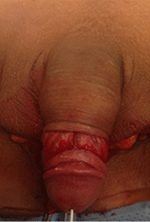
Figure 1. The initial circumferential subcoronal incision.
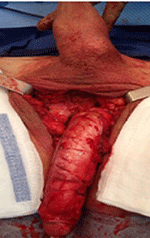
Figure 2. The de-gloved penis existence passed through the scrotal opening.
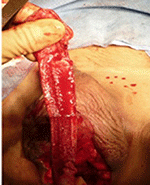
Figure 3. The dorsal part of the glans and its neurovascular bundle dissected away from the penile shaft.
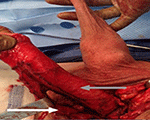
Figure 4. The urethra dissected including a portion of the bulbospongious muscle. The grey pointer shows the penile shaft and the white pointer shows the dissected urethra.
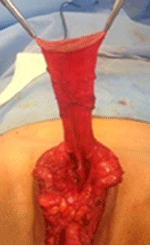
Effigy v. The inverted penile pare flap.
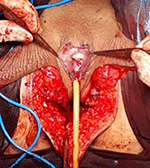
Figure six. The neoclitoris and the urethra sutured in the midline and the neovaginal cavity.
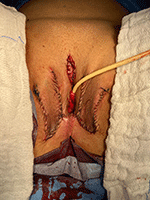
Figure vii. The last advent after the completion of the procedures.
Postoperative Intendance and Follow-Up
The patients were commonly discharged inside 2 days afterward surgery with the Foley catheter and vaginal gauze packing in place, which were removed after seven days in an ambulatorial omnipresence.
Our vaginal dilation protocol starts seven days afterward surgery: a kit of six silicone dilators with progressive diameter (1.i–4 cm) and length (half dozen.5–fourteen.five cm) is used; dilation is done progressively from the smallest dilator; each size should be kept in place for 5 min until the largest possible size, which is kept for iii h during the solar day and during the nighttime (sleep), if possible. The process is performed daily for the get-go 3 months and continued until the patient has regular sexual intercourse.
The follow-up visits were performed 7 days, one, 2, iii, 6, and 12 months after surgery (Figure 8), and included concrete exam and a quality-of-life questionnaire.
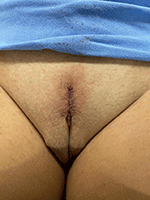
Figure 8. Appearance afterwards i month of the process.
Statistical Analysis
The statistical assay was conducted using Statistical Product and Service Solutions Version 18.0 (SPSS). Outcome measures were intra-operative and postoperative complications, re-operations. Descriptive statistics were used to evaluate the report outcomes. Hateful values and standard deviations or median values and ranges are presented as continuous variables. Frequencies and percentages are reported for dichotomous and ordinal variables.
Results
Patient Demographics
During the menses of the study, 214 patients underwent penile inversion vaginoplasty, performed by two staff surgeons, mostly assisted past residents (Table one). The average age at the fourth dimension of surgery was 32.2 years (range eighteen–61 years). There was no significant increase or decrease in the ages of patients who underwent SRS over the study menstruum (Fisher's exact exam: P = 0.065; chi-square test: 10 ii = 5.15; GL = half dozen; P = 0.525). The average of operative fourth dimension was iii.three h (range 2–5 h). The boilerplate duration of hormone therapy before surgery was 12 years (range 1–39). The majority of patients were white (88.3 percent). The most prevalent patient comorbidities were history of tobacco utilize (xv percent), human immunodeficiency virus infection (13 percent) and hypertension (10.7 percent). Other comorbidities are listed in Table ane.
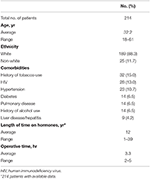
Table i. Patient demographics.
Multidisciplinary follow-upward was comprised of 93.45% of patients post-obit upwardly with a urologist and 59.06% of patients continuing psychiatric follow-upwardly, median follow-upwardly fourth dimension of 16 and 9.three months after surgery, respectively.
Postoperative Results
The complications were classified according to the Clavien-Dindo score (Tabular array 2). The most common minor postoperative complications (Grade I) were granulation tissue (20.5 percent), introital stricture of the neovagina (15.4 percent) and wound dehiscence (12.six percent). The major complications (Class Three-IV) included urethral stenosis (twenty.5 percent), urethral fistula (1.9 per centum), intraoperative rectal injury (1.9 percent), necrosis (primarily along the wound edges) (one.4 percent), and rectovaginal fistula (0.nine percent). A total of 17 patients required claret transfusion (seven.9 percent).

Table 2. Complications afterward penile inversion vaginoplasty.
A total of 36 patients (16.viii percent) underwent some class of reoperation.
One hundred eighty-one (85 percent) patients in our series were able to have regular sexual vaginal intercourse, and no private regretted having undergone GAS.
Discussion
Penile inversion vaginoplasty is the gold-standard in gender-affirming surgery. It has adept functional outcomes, and studies have demonstrated adequate vaginal depths (3). Information technology is recognized not just as a cosmetic process, but as a therapeutic intervention and a medical necessity (two). We present the largest South-American cohort to date, examining demographic information, intra and postoperative complications.
The mean age of transsexual women who underwent GAS in our study was 32.2 years (range 18–61 years), which is lower than the mean age of patients in studies found in the literature. 2 studies indicated that the mean ages of patients at time of GAS were 36.vii years and 41 years, respectively (4, 5). Another study reported a mean age at fourth dimension of GAS of 36 years and found there was a significant decrease in historic period at the time of GAS from 41 years in 1994 to 35 years in 2015 (7). According to the authors, this decrease in age is associated with greater tolerance and societal approval regarding individuals with GD (7).
There was no grade IV or grade 5 complications. Excessive bleeding noticed postoperatively occurred in 19 patients (8.9 percentage) and blood transfusion was required in 17 cases (7.9 percent); all patients who required claret transfusions were operated until July 2011, and the reason for this rate of blood transfusion was not identified.
The virtually common intraoperative complication was rectal injury, occurring in iv patients (1.9 percent); in all patients the lesion was promptly identified and corrected in 2 layers absorbable sutures. In 2 of these patients, a rectovaginal fistula became axiomatic, requiring fistulectomy and colonic transit deviation. This is consistent with current literature, in which rectal injury is reported in 0.iv–4.5 percent of patients (4, 5, 8–13). Goddard et al. suggested carefully checking for enterotomy afterwards prostate and float mobilization by digital rectal examination (4). Gaither et al. (xiv) commented that conscientious dissection that closely follows the urethra along its track from the cardinal tendon of the perineum up through the lower pole of the prostate is disquisitional and simply blunt autopsy is encouraged after Denonvilliers' fascia is reached. Alternatively, a robotic-assisted approach to penile inversion vaginoplasty may aid in minimizing these complications. The proposed advantages of a robotic-assisted vaginoplasty include safer dissection to minimize the risk of rectal injury and better proximal vaginal fixation. Dy et al. (xv) has had no rectal injuries or fistulae to appointment in his series of fifteen patients, with a mean follow-upwards of 12 months.
In our series, nosotros observed 44 cases (20.5 percent) of urethral meatus strictures. We credit this complication to the technique used in the initial 5 years of our experience, in which the urethra was shortened and sutured in a circular style without spatulation. All cases were treated with meatal dilatation and xi patients required surgical correction, existence performed a Y-V plastic reconstruction of the urethral meatus. In the literature, meatal strictures are relatively rare in male-to-female (MtF) GAS due to the spatulation of the urethra and a uncomplicated anastomosis to the external ballocks. Recent systematic reviews evidence an incidence of five percent in this complication (16, 17). Other studies report a wide incidence of meatal stenosis ranging from 1.1 to 39.8 percent (4, viii, 11).
Neovagina introital stricture was observed in 33 patients (15.4 per centum) in our report and impedes the possibility of neovaginal penetration and/or adversely affects sexual life quality. In the literature, the reported incidence of introital stenosis range from 6.vii to fourteen.v percent (4, 5, viii, 9, 11–thirteen). According to Hadj-Moussa et al. (18) a regimen of postoperative prophylactic dilation is crucial to minimize the development of this consequence. At our establishment, our protocol for vaginal dilation started vii days afterwards surgery and was performed iii to four times a day during the first 3 months and was continued until the individual had regular sexual intercourse. Nosotros treated stenosis initially with dilation. In case of no response, we advise a surgical revision with diamond-shaped introitoplasty with relaxing incisions. In recalcitrant cases, we proposed to the patient a secondary vaginoplasty using a full-thickness skin graft of the lower abdomen.
One hundred 80-one (85 percent) patients were classified as having a "functional vagina," characterized as the capacity to maintain satisfactory sexual vaginal intercourse, since the mean neovaginal depth was not measured. In a review article, the mean neovaginal depth ranged from ten to 13.five cm, with the shallowest neovagina depth at 2.5 cm and the deepest at 18 cm (17). Co-ordinate to Salim et al. (19), in terms of postoperative functional outcomes after penile inversion vaginoplasty, a mean percentage of 75 percent (range from 33 to 87 percent) patients were having vaginal intercourse. Hess et al. found that 91.4% of patients who responded to a questionnaire were very satisfied (34.4%), satisfied (37.half dozen%), or mostly satisfied (19.4%) with their sexual function after penile inversion vaginoplasty (20).
Poor corrective appearance of the vulva is common. Ameliorate et al. reported that the nearly common reason for reoperation was cosmetic correction in the class of mons pubis and mucosa reduction in 50% of patients (xvi). Nosotros had no patient regrets virtually performing GAS, although 36 patients (xvi.eight percentage) were reoperated due to corrective issues. Gaither et al. propose in order to minimize scarring to utilize a one-stage surgical approach and the lateralization of surgical scars to the groin (14). Frequently, cosmetic issues outcomes are often patient driven and preoperative patient education is necessary (14).
Analyzing the quality of life, in 2016, our health care group (PROTIG) published a study assessing quality of life before and afterwards gender-affirming surgery in 47 patients using the diagnostic tool 100-particular WHO Quality of Life Assessment (WHOQOL-100) (21). The authors constitute that GAS promotes the improvement of psychological aspects and social relations. However, even 1 year after GAS, MtF persons continue to report problems in concrete and difficulty in recovering their independence. In a systematic review and meta-analysis of QOL and psychosocial outcomes in transsexual people, researchers verified that sex reassignment with hormonal interventions more probable corrects gender dysphoria, psychological functioning and comorbidities, sexual part, and overall QOL compared with sex reassignment without hormonal interventions, although there is a low level of show for this (22). Recently, Castellano et al. assessed QOL in 60 Italian transsexuals (46 transwomen and fourteen transmen) at least 2 years after SRS using the WHOQOL-100 (general QOL score and quality of sexual life and quality of body image scores) to focus on the furnishings of hormonal therapy. Overall satisfaction improved after SRS, and QOL was similar to the controls (23). Bartolucci et al. evaluated the perception of quality of sexual life using four questions evaluating the sexual facet in individuals with gender dysphoria before SRS and the possible factors associated with this perception. The study showed that approximately half the subjects with gender dysphoria perceived their sexual life as "poor/dissatisfied" or "very poor/very dissatisfied" before SRS (24).
Our study has some limitations. The total number of operated patients is restricted within the long follow-upward flow. This is due to a limitation in our health organization, which allows only 1 sexual reassignment surgery to be performed per month at our institution. Neovagin depth measurement was not performed routinely in the follow-upwards of operated patients.
Conclusions
The definitive treatment for patients with gender dysphoria is gender-affirming surgery. Our serial demonstrates that GAS is a feasible surgery with depression rates of serious complications. We emphasize the loftier level of functionality of the vagina after the procedure, likewise as subjective personal satisfaction. Complications, especially minor ones, are probably underestimated due to the nature of the study, and since this is a surgical population, the results may not be generalizable for all transgender MTF individuals.
Data Availability Statement
The raw data supporting the conclusions of this article will be made available by the authors, without undue reservation.
Ethics Statement
The studies involving human participants were reviewed and approved by Hospital de Clínicas de Porto Alegre. The patients/participants provided their written informed consent to participate in this study.
Author Contributions
GM: conception and design, data acquisition, information analysis, interpretation, drafting the manuscript, review of the literature, critical revision of the manuscript and factual content, and statistical analysis. ML and TR: conception and design, information interpretation, drafting the manuscript, critical revision of the manuscript and factual content, and statistical analysis. DS, KS, AF, AC, PT, AG, and RC: conception and design, data acquisition and information analysis, interpretation, drafting the manuscript, and review of the literature. All authors contributed to the article and approved the submitted version.
Funding
This written report was supported by the Fundo de Incentivo à Pesquisa e Eventos (FIPE - Fundo de Incentivo à Pesquisa e Eventos) of Hospital de Clínicas de Porto Alegre.
Conflict of Interest
The authors declare that the enquiry was conducted in the absenteeism of any commercial or financial relationships that could be construed equally a potential disharmonize of interest.
References
1. Coleman East, Bockting Due west, Botzer Grand, Cohen-Kettenis P, DeCuypere G, Feldman J, et al. Standards of care for the wellness of transsexual, transgender, and gender-non-conforming people, version 7. Int J Transgend. (2012) xiii:165–232. doi: ten.1080/15532739.2011.700873
CrossRef Total Text | Google Scholar
2. Massie JP, Morrison SD, Maasdam JV, Satterwhite T. Predictors of patient satisfaction and postoperative complications in penile inversion vaginoplasty. Plast Reconstruct Surg. (2018) 141:911–921. doi: x.1097/PRS.0000000000004427
PubMed Abstract | CrossRef Total Text | Google Scholar
4. Goddard JC, Vickery RM, Qureshi A, Summerton DJ, Khoosal D, Terry TR. Feminizing genitoplasty in adult transsexuals: early and long-term surgical results. BJU Int. (2007) 100:607–13. doi: 10.1111/j.1464-410X.2007.07017.ten
PubMed Abstruse | CrossRef Full Text | Google Scholar
5. Rossi NR, Hintz F, Krege S, Rübben H, Vom DF, Hess J. Gender reassignment surgery – a 13 yr review of surgical outcomes. Eur Urol Suppl. (2013) 12:e559. doi: 10.1016/S1569-9056(thirteen)61042-viii
PubMed Abstruse | CrossRef Full Text | Google Scholar
six. Silva RUM, Abreu FJS, Silva GMV, Santos JVQV, Batezini NSS, Silva Neto B, et al. Pace past step male person to female transsexual surgery. Int Braz J Urol. (2018) 44:407–8. doi: x.1590/s1677-5538.ibju.2017.0044
PubMed Abstract | CrossRef Total Text | Google Scholar
vii. Aydin D, Buk LJ, Partoft S, Bonde C, Thomsen MV, Tos T. Transgender surgery in Kingdom of denmark from 1994 to 2015: 20-year follow-upwards study. J Sexual practice Med. (2016) xiii:720–five. doi: ten.1016/j.jsxm.2016.01.012
PubMed Abstruse | CrossRef Full Text | Google Scholar
8. Perovic SV, Stanojevic DS, Djordjevic MLJ. Vaginoplasty in male transsexuals using penile skin and a urethral flap. BJU Int. (2001) 86:843–50. doi: 10.1046/j.1464-410x.2000.00934.10
PubMed Abstract | CrossRef Full Text | Google Scholar
9. Krege S, Bex A, Lümmen 1000, Rübben H. Male person-to-female transsexualism: a technique, results and long-term follow-up in 66 patients. BJU Int. (2001) 88:396–402. doi: 10.1046/j.1464-410X.2001.02323.10
PubMed Abstruse | CrossRef Full Text | Google Scholar
x. Wagner South, Greco F, Hoda MR, Inferrera A, Lupo A, Hamza A, et al. Male person-to-female transsexualism: technique, results and 3-year follow-upward in 50 patients. Urol International. (2010) 84:330–3. doi: 10.1159/000288238
PubMed Abstract | CrossRef Full Text | Google Scholar
12. Raigosa Yard, Avvedimento Due south, Yoon TS, Cruz-Gimeno J, Rodriguez G, Fontdevila J. Male-to-female genital reassignment surgery: a retrospective review of surgical technique and complications in 60 patients. J Sex Med. (2015) 12:1837–45. doi: ten.1111/jsm.12936
PubMed Abstract | CrossRef Full Text | Google Scholar
13. Sigurjonsson H, Rinder J, Möllermark C, Farnebo F, Lundgren TK. Male to female gender reassignment surgery: surgical outcomes of sequent patients during 14 years. JPRAS Open up. (2015) half-dozen:69–73. doi: 10.1016/j.jpra.2015.09.003
CrossRef Full Text | Google Scholar
14. Gaither TW, Awad MA, Osterberg EC, Spud GP, Romero A, Bowers ML, et al. Postoperative complications following primary penile inversion vaginoplasty among 330 male-to-female transgender patients. J Urol. (2018) 199:760–5. doi: 10.1016/j.juro.2017.ten.013
PubMed Abstract | CrossRef Full Text | Google Scholar
17. Horbach SER, Bouman MB, Smit JM, Özer Thou, Buncamper ME, Mullender MG. Effect of vaginoplasty in male-to-female person transgenders: a systematic review of surgical techniques. J Sex Med. (2015) 12:1499–512. doi: 10.1111/jsm.12868
PubMed Abstruse | CrossRef Total Text | Google Scholar
xviii. Hadj-Moussa M, Ohl DA, Kuzon WM. Feminizing genital gender-confirmation surgery. Sex Med Rev. (2018) vi:457–68.e2. doi: 10.1016/j.sxmr.2017.eleven.005
CrossRef Total Text | Google Scholar
19. Salim A, Poh M. Gender-affirming penile inversion vaginoplasty. Clin Plast Surg. (2018) 45:343–l. doi: ten.1016/j.cps.2018.04.001
CrossRef Full Text | Google Scholar
21. Silva DC, Schwarz K, Fontanari AMV, Costa AB, Massuda R, Henriques AA, et al. WHOQOL-100 before and after sex reassignment surgery in brazilian male-to-female person transsexual individuals. J Sex activity Med. (2016) xiii:988–93. doi: ten.1016/j.jsxm.2016.03.370
PubMed Abstruse | CrossRef Total Text | Google Scholar
22. Murad MH, Elamin MB, Garcia MZ, Mullan RJ, Murad A, Erwin PJ, et al. Hormonal therapy and sexual activity reassignment: a systematic review and meta-analysis of quality of life and psychosocial outcomes. Clin Endocrinol. (2010) 72:214–31. doi: 10.1111/j.1365-2265.2009.03625.ten
PubMed Abstract | CrossRef Total Text | Google Scholar
23. Castellano East, Crespi C, Dell'Aquila C, Rosato R, Catalano C, Mineccia V, et al. Quality of life and hormones after sex reassignment surgery. J Endocrinol Invest. (2015) 38:1373–81. doi: ten.1007/s40618-015-0398-0
PubMed Abstract | CrossRef Full Text | Google Scholar
24. Bartolucci C, Gómez-Gil E, Salamero 1000, Esteva I, Guillamón A, Zubiaurre L, et al. Sexual quality of life in gender-dysphoric adults before genital sex reassignment surgery. J Sex Med. (2015) 12:180–8. doi: 10.1111/jsm.12758
PubMed Abstract | CrossRef Full Text | Google Scholar
Who A Female Gender Is Change To Male,
Source: https://www.frontiersin.org/articles/10.3389/fsurg.2021.639430/full
Posted by: martinfelainum51.blogspot.com


0 Response to "Who A Female Gender Is Change To Male"
Post a Comment